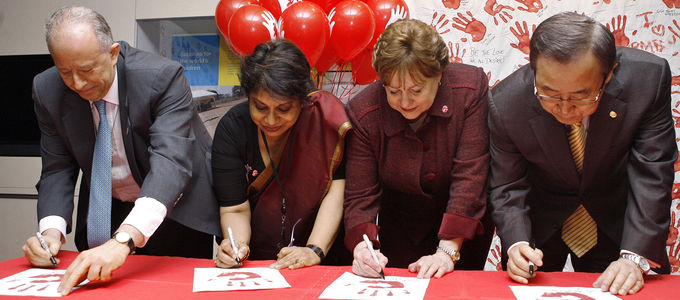
What does he want to become when he is older? “A soldier,” replies the six-year-old boy. Why on earth would you say that? “Because then I will be able to kill people!” The young lad is deadly serious. Today’s commemoration of “Red Hand Day” serves as a reminder about this reality.
There is a reason behind this young child’s wish: his family was killed right before his eyes. What the boy wants is not necessarily revenge, but simply survival—and the best way to ensure this is with a weapon in his hand.
Lucie Bindu (28) is all too familiar with scenarios such as this from her time as a journalist in the Democratic Republic of Congo. Today she lives in Oslo, Norway, where she is not only active in her home congregation, but also still committed—even from afar—to the cause of these victims of war and violence in her homeland.
Kidnapped, enslaved, raped
It began in the mid-1990s in the civil wars that surrounded the overthrow of the dictator Mobutu, and it has been recurring in the Eastern Congo conflict since the beginning of the past decade, explains Lucie Bindu: warlords are “recruiting” child soldiers.
These are children who either lost sight of their parents or who watched them die when their home villages were attacked, or often also children who were simply torn from their homes and kidnapped during such attacks.
These children are kept as house slaves. The girls are repeatedly raped, and the young boys are forced to take up a weapon at some point, “even if it is only a machete,” says the journalist.
Why children in particular? “They are easier to influence and intimidate,” explains the 28-year-old. Beyond that, they are—and here the cynicism of war becomes evident—cheaper for the militia leaders to maintain.
The red hand as a stop sign
UNICEF, the United Nations Children’s Fund, reports that there are also significant numbers of child soldiers in South Sudan, the Central African Republic, Somalia, Syria, and Yemen. According to estimates, there are some 250,000 child soldiers currently bearing arms around the world.
The UN Special Envoy Olara Ottuno estimates that approximately two million children were killed between 1990 and 2000 alone. According to the same estimates, some six million children were crippled, and ten million children suffered significant psychological trauma.
On 12 February, the “International Day Against the Use of Child Soldiers” commemorates the fates of these children. It was on this day in 2002 that the Optional Protocol to the Convention on the Rights of the Child—which makes the recruitment of children under fifteen years of age a war crime—entered into effect. The nickname “Red Hand Day” stems from protest campaigns in which red handprints served as a stop signal.
The long and difficult way home
The agreement has sparked debates and legislative changes around the world. And an ever increasing number of aid programmes now aim to liberate child soldiers and help them rebuild a normal life. However, it is a long and brutal path for those affected.
“Even when such child soldiers manage to escape or make an exit, they are seldom welcomed back into their home villages,” reports Lucie Bindu, “because these are the ones who have murdered.” And even if they manage to find a place in an aid programme, many children do not succeed in their attempts at withdrawal from the drugs the warlords used to make them compliant.
Yet there are also other hopeful cases, says the journalist. For example, she relates the following story of a 16-year-old: “He has survived two wars. And he is tired of seeing his friends die.” With the support of aid organisations, he has built a new life for himself by selling prepaid cards for cell phones at a small kiosk. “He is so happy to be part of society again and to be able to contribute something to it.”
The 28-year-old is not aware of any such stories involving children from New Apostolic families, but that does not mean anything. “Don’t think. Don’t feel. Just carry on”—for those affected, this is often the only possible survival technique. And here the Christian demands to love one’s neighbour—not to mention one’s enemy—take on a whole new dimension. “This is a completely different world.”














